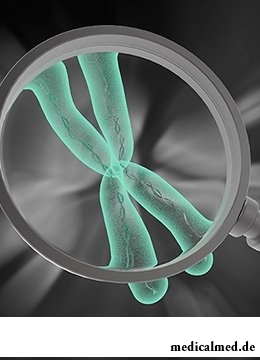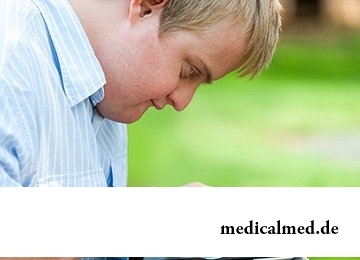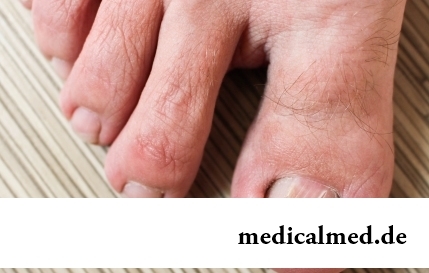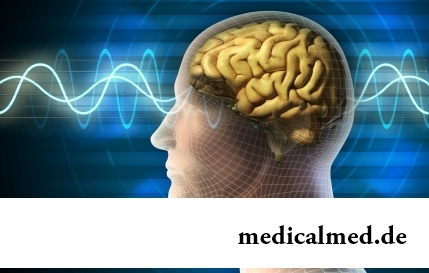





Pradera-Willie's syndrome
 Pradera-Willie's syndrome in medicine call a rare hereditary disease of which absence or insufficient functioning of some genes or their parts of the 15th fatherly chromosome is characteristic. For the first time this pathology was described in 1956 in Switzerland by pediatricians A. Prader and H. Willie on whose surnames the syndrome is called. Frequency makes it 1 case on 12-15 000 newborn children. Symptoms and manifestations of a syndrome of Pradera-Willie happen various, and the course of a disease depends, as a rule, on a specific case.
Pradera-Willie's syndrome in medicine call a rare hereditary disease of which absence or insufficient functioning of some genes or their parts of the 15th fatherly chromosome is characteristic. For the first time this pathology was described in 1956 in Switzerland by pediatricians A. Prader and H. Willie on whose surnames the syndrome is called. Frequency makes it 1 case on 12-15 000 newborn children. Symptoms and manifestations of a syndrome of Pradera-Willie happen various, and the course of a disease depends, as a rule, on a specific case.
Signs of a syndrome of Pradera-Willie
Some signs of a syndrome of Pradera-Willie can be found at a pregnancy stage. First of all, it is low mobility of a fruit and its wrong situation. After the birth the hypomyotonia which remains for the first year of life of the kid is expressed. Besides, at children with a syndrome decrease in deglutitory and sucking reflexes is shown that complicates feeding process. Disturbance of development of motive functions at them is also caused by a hypomyotonia therefore it is difficult for sick children to sit, hold the head, etc. However it is important to note that hypotonia decreases and to age of 6-7 years practically disappears.
Pradera-Willie's syndrome at children is also shown by constant feeling of hunger and lack of saturation. This symptom of a disease usually arises during a second or fourth the child's lives. On this background the hyperphagia or a gluttony, the notions of compulsion about food and obsessivny behavior which is sent to continuous questings and satisfaction of feeling of hunger gradually develops. Such symptoms inevitably lead to obesity which in case of this disease is observed generally on a trunk and proximal departments of extremities. Quite often leads these signs of a syndrome of Pradera-Willie at children to such complication as obstructive to the apnoea which is shown an apnoea in a dream.
Act as other typical symptoms of a disease:
- Decrease in growth;
- The extended shape of the head;
- Amygdaloid section of eyes;
- Wide nose bridge;
- Thin upper lip and small mouth;
- Low located auricles;
- Acromicria (disproportionally small brushes and feet);
- Weak xanthopathy, irises and a hair which is observed in 75% of cases of a disease;
- Dysplasia of hip joints;
- Rachiocampsis;
- The lowered density of bones;
- The increased drowsiness;
- Squint (strabismus);
- Dense saliva and problems with teeth;
- Late puberty.
Already at the birth Pradera-Willie's syndrome at children is shown by disturbance of development of generative organs. At boys with this disease the underdevelopment of a penis and a scrotum is observed, and the level of testosterone is sharply reduced, girls have an underdevelopment of vulvar lips and quite often a uterus. Further the disease results in absence or a delay of puberty and infertility.
One of the main signs of a syndrome of Pradera-Willie is also the delay of psychomotor development. The coefficient of intellectual development at patients makes 20-80 units whereas norm is the indicator of 85-115 units. Together with it the children having this disease, as a rule, have good visual memory, can learn to read and even to possess quite rich passive dictionary, however their speech is much worse, than understanding.
Pradera-Willie's syndrome at children usually is followed by bad acoustical and visual memory, mathematical skills and writing skills are given them very difficult. It should be noted that quite often at children with such syndrome the diabetes mellitus develops.
Diagnosis of a syndrome of Pradera-Willie
Early diagnosis of a syndrome of Pradera-Willie and the subsequent treatment allow to improve the forecast of development of a disease. The diagnosis is made, as a rule, on the basis of clinical displays of a disease, but genetic testing which specialists recommend first of all for newborns is often used today. It is caused by the fact that at children to define existence of a syndrome much more difficultly as it is impossible to check their abilities allowing to carry out diagnosis of a syndrome of Pradera-Willie on clinical manifestations.
Genetic testing is held by a DNA methylation method for the purpose of examination whether are present at the 15th chromosome of a deviation, the diseases leading to emergence. This way of diagnosis of a syndrome of Pradera-Willie helps to reveal 97% of cases of a disease.
It is also worth noting that often the disease is diagnosed incorrectly as it is quite often confused to a Down syndrome which meets much more often. Besides such characteristic sign of a syndrome of Pradera-Willie as obesity, can be present also at a Down syndrome. For this reason huge number of cases of a disease remain not revealed.
Treatment of a syndrome of Pradera-Willie
 As the disease is genetic anomaly, for treatment of a syndrome of Pradera-Willie there are no effective medicines today. Together with it some medical actions helping to improve quality of life of patients are applied. First of all they have to be directed to increase in a muscle tone therefore sick children need special massage procedures and physical therapy.
As the disease is genetic anomaly, for treatment of a syndrome of Pradera-Willie there are no effective medicines today. Together with it some medical actions helping to improve quality of life of patients are applied. First of all they have to be directed to increase in a muscle tone therefore sick children need special massage procedures and physical therapy.
Treatment of a syndrome of Pradera-Willie includes also diets with restriction of fats and carbohydrates. To avoid obesity, it is necessary to watch quality and caloric content of the eaten food constantly. Besides, at treatment use of hormonal therapy by means of gonadotrophins which allow to increase growth of the sick child is quite often recommended and to recover a tone of muscles. It promotes the correct distribution of calories in an organism, interfering with obesity.
Treatment of a syndrome of Pradera-Willie also assumes special techniques of development of sick children, occupations with the speech pathologist, the logopedist and the psychologist.
The well-known drug "Viagra" was initially developed for treatment of an arterial hypertension.

No, probably, the person who would not have cold. Cold, cough, a headache – these symptoms are known to everyone. Peak to Prost...
Section: Articles about health
For many spouses the question of planning of a family is one of the main. The problem of the choice of effective and safe contraceptives at the same time comes out on top. Russians still not often resort to operation of a vasectomy extremely popular in the USA...
Section: Articles about health
All parents are ready to what the baby often and pisat much. Since then, as the absorbing diapers strongly became current, keeping of the kid in dryness does not represent any problems. But if the grown-up kid continues to urinate in panties, parents begin to feel concern – whether it is normal, or the kid has an urine incontience? Let's try to understand what is enuresis why it arises at children and at what age it is necessary to begin it to treat....
Section: Articles about health
The word "onikhokriptoz" is unfamiliar to most of people, meanwhile quite so physicians call very widespread problem: growing...
Section: Articles about health
Physical activity is necessary for normal functioning of a human body. At a lack of the movement joints cease to function, muscles atrophy, cardiovascular activity is broken and the metabolism worsens. Modern городс...
Section: Articles about health
The sudden heat on all body which is followed by perspiration and a cardiopalmus – the phenomenon familiar to many people. Most often such states called by "inflows" result from nervous or physical overworks and disappear right after rest. However in certain cases similar reaction of an organism can speak about diseases which need treatment. What? About it below....
Section: Articles about health
The person, as well as all other beings living on our planet feels weather changing. It is normal meteosensitivity, not...
Section: Articles about health
Childbirth is the most important event in life of each woman. We are women we give birth to the new little man on this light. Now the tendency to that was outlined, as men want to participate in labor too. But there is a question and whether it is worth allowing the husband...
Section: Articles about health
Turnip, radish, horse-radish – once these and other products enjoyed wide popularity at our ancestors, being not only the food sating an organism but also the medicines curing of many diseases. Unfortunately, the use of some of them got out of fashion long ago, and once favourite plants and vegetables almost ceased to make a contribution to human health. Inclusion of such products in a modern diet − an effective measure of prevention and treatment of diseases which seldom suffered...
Section: Articles about health
Life of the modern child is extremely active and difficult. Information strain which is experienced by the school student and did not dream the pupil...
Section: Articles about health
So, you resolved to lose weight. And now you try to understand what to begin with: from exercise stresses or a diet? And how to make that process of weight loss did not give you an inconvenience, and, on the contrary, brought joy?...
Section: Slideshow
Tea is loved and use almost everything. This drink has tonic properties, contains the tannins capable to suppress activity of causative organisms. Recently great popularity was gained by teas with vegetable additives. The medicative herbs, spices and fruit which are a part of such mixes enrich drink with vitamins and microelements, increasing its nutritional value and creating additional curative effect....
Section: Articles about health
According to data of World Health Organization, the cataract is diagnosed almost for 7% of the population of Earth. Statistics we get sick...
Section: Articles about health
Traveling all over the world, many try to try the most exotic dishes of national cuisines. There is even a so-called gastronomic tourism which, according to gourmets, not only allows to receive new feelings, but also is capable to show life the friend...
Section: Articles about health
Some people consider what for medicine of the 21st century of secrets in the field of health of the person almost does not exist. It absolutely not so. The more answers scientists receive, the more the most difficult questions are raised for them by life. Besides, there are diseases which are not explained with science in any way of which existence people know for 100-150 years. These diseases meet not so often, but from some of them nobody is insured....
Section: Articles about health
The brain of the person is studied not one hundred years, but the quantity of the riddles connected with this body increases rather, than reducing...
Section: Articles about health
Such trouble as the milkwoman's attack, at least once in life happened almost to each woman. Prevalence of a disease is explained by the fact that the causative agent of an illness belongs to the so-called opportunistic microflora living on mucous an obol...
Section: Articles about health
Color of plants is caused by presence at them of certain chemical compounds. Let's talk about what is meant by various colors of vegetables and fruit and what properties they give them....
Section: Articles about health
Let's begin with the fact that a separate illness which is called "adjournment of salts", just does not exist. In practice this household name of plank beds...
Section: Articles about health
The nature does not stand stagnation and monotony. It is known that tissues of a human body atrophy if do not receive necessary loadings. It fully belongs also to a cerebral cortex: when it is not given full-time job, it begins to function worse. In резуль...
Section: Articles about health
Not everyone can brag of the shining Hollywood smile. Even the person who is regularly visiting the stomatologist and watching of oral cavities over health periodically has problems: enamel of teeth darkens under the influence of some products, on it the deposits giving to teeth a grayish or yellowish shade collect....
Section: Articles about health
Statistically, pathologies of a thyroid gland in the world more than 500 million people have. Failures in work of this body conduct to is heavy...
Section: Articles about health
Each of us repeatedly noticed that the people having the same passport age are sometimes not similar on one-years at all. One at the age of 40-45 years already looks almost an old man, and another and in 60 is young, vigorous and full of life. The matter is that state нашег...
Section: Articles about health
Smack in a mouth can arise in the natural way – as a result of lack of morning hygiene or reception of the corresponding food. However in certain cases its existence is a sign of certain pathologies, and allows to reveal an illness at an early stage. Depending on character of aftertaste – acid, salty, bitter, sweet – distinguish also diseases which accompany it....
Section: Articles about health
Dark circles (bruises) under eyes – a shortcoming with most of which often fight against the help of cosmetics (proofreaders, salons...
Section: Articles about health
Healthy lifestyle today in fashion, and many parents think of that the child from the early childhood played sports. Trainings will help it to become strong and hardy, will improve coordination of movements, and also will exert positive impact on mentality: it...
Section: Articles about health
Stroke (acute disorder of cerebral circulation) – one of the most widespread neurologic diseases. Annually in the world more than 6 million people die of this illness. From the survived patients about 80% become disabled people, and nearly a third from them needs afterwards permanent care. In fact, the stroke creates a situation at which a part of cells of a brain loses blood access, loses an opportunity to receive oxygen and nutrients, and perishes. As a result of a razviv...
Section: Articles about health
